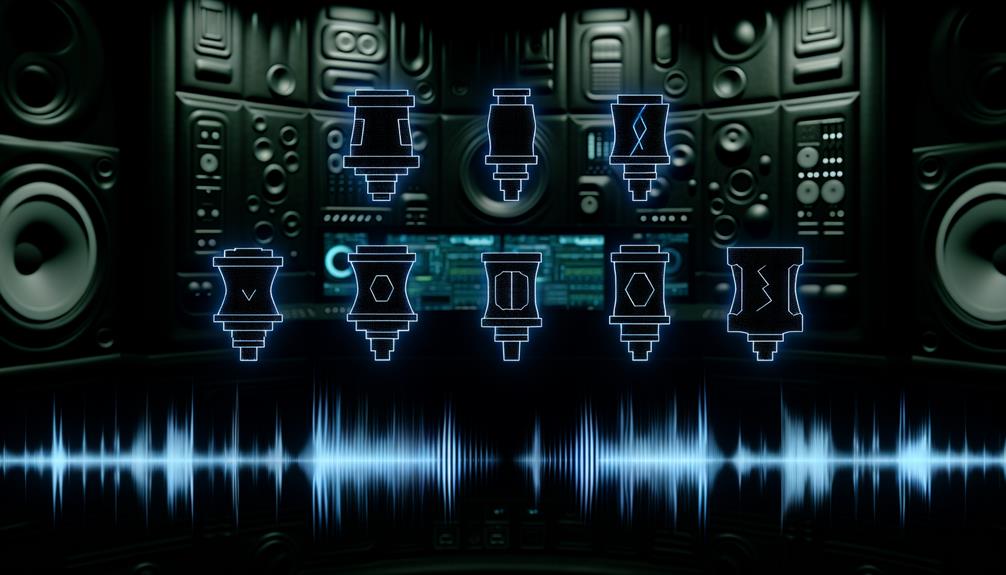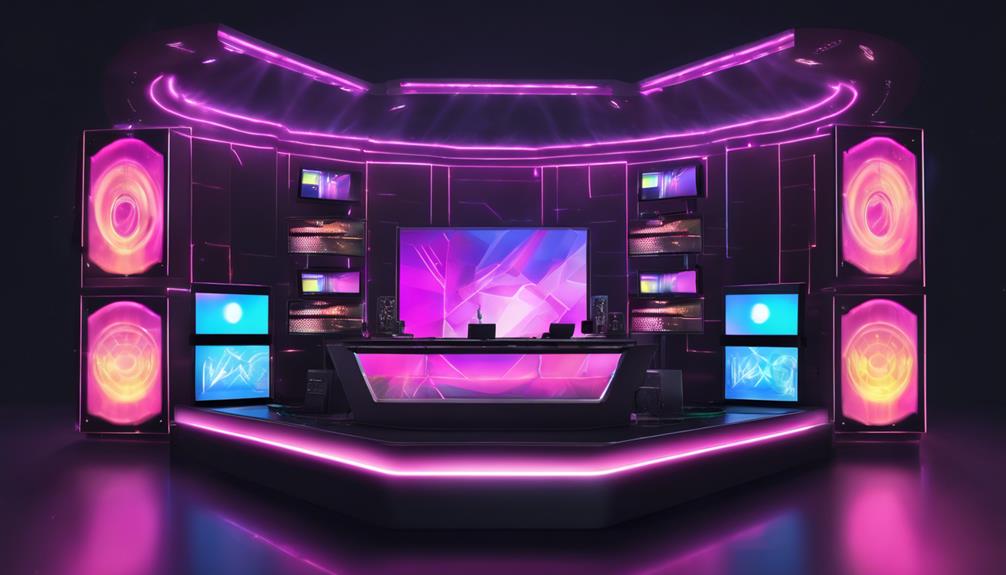No products in the cart.
You’ll need the best audio interfaces for peak FL Studio productions in 2024. The Universal Audio Apollo Twin X QUAD HE tops the list with its Vintage mode and high-quality mic preamps, perfect for professional results. For budget-conscious options, the Behringer UMC22 delivers quality at 24-bit/192kHz with low latency. Professionals might prefer interfaces with robust preamps and multiple outputs, ensuring intricate setup capabilities and minimal latency. Consider connectivity too; USB Type-C like on the Steinberg UR44C offers faster data transfer. Make sure your choice matches FL Studio’s requirements for seamless integration. Exploring these recommendations will further enhance your studio’s capabilities.
Key Takeaways
- Universal Audio Apollo Twin X QUAD HE offers professional-grade quality with Vintage mode for analog sound emulation.
- Behringer UMC22 provides a budget-friendly option with high-resolution audio and USB Type-C connectivity.
- Steinberg UR44C features USB 3.0 for faster data transfer, ideal for FL Studio users.
- PreSonus Studio 24c ensures low latency and high audio quality, suitable for detailed productions.
- Focusrite Scarlett Solo offers great compatibility and performance with USB Type-C, perfect for FL Studio.
Selecting Your Audio Interface
When selecting an audio interface for FL Studio, it’s important to take into account connectivity options like USB Type-C or USB 2.0 for smooth integration. Interface connectivity is the backbone of your setup, guaranteeing that data transfers quickly and reliably between your interface and computer. You’ll want to opt for an interface that supports USB 3.0 if you’re looking for higher data throughput, which is especially beneficial for larger projects with multiple tracks and high-resolution audio.
Speaking of audio quality, it’s essential to choose an interface that can handle high-resolution audio up to 24-bit/192kHz. This capability ensures that your recordings capture every nuance and detail, providing a crystal-clear playback experience. High-resolution audio is a must if you aim to produce professional-quality tracks that stand up to scrutiny.
Also, look for an interface that offers plug-and-play functionality. This feature simplifies the setup process, allowing you to focus more on your music rather than technical setup hurdles. Opting for an interface with a compact design and multiple outputs can further enhance your experience, giving you greater flexibility and ease of use in various recording environments.
Best Overall Performance
For unparalleled audio performance in FL Studio, the Universal Audio Apollo Twin X QUAD HE stands out as the top choice for 2024. This audio interface not only delivers exceptional sound quality but also features Vintage mode, imbuing your recordings with warmth and character that’s often sought after in professional productions. The integration with various devices and compatibility with the LUNA Recording System make it a versatile choice for your studio setup.
The Apollo Twin X QUAD HE boasts high-quality mic preamps and an innovative Air mode, enhancing clarity and adding a high-end sheen to your vocal tracks. This makes it a superior option in any audio interface comparison, particularly for those who demand professional-grade results in their music production. Its reliability and advanced features are why it’s a favorite among FL Studio users.
When you’re exploring audio interface options, consider how the Apollo Twin X QUAD HE utilizes its Vintage mode applications to replicate analog sounds, a feature that stands out in the market. This interface isn’t just about connectivity and functionality; it’s about elevating your music to meet industry standards effortlessly.
Top Budget-Friendly Choice
As you explore budget-friendly options for FL Studio, it’s important to assess the essential features that the Behringer UMC22 offers.
You’ll find its price-to-performance ratio quite attractive, especially when compared to other popular models in the market.
This comparison will help you decide if the UMC22 meets your recording and mixing needs without straining your finances.
Essential Features Overview
You’ll appreciate the excellent budget-friendly audio interface for FL Studio, which delivers a crystal-clear 24-bit/192kHz resolution for your recordings. This feature is vital for ensuring that your audio quality is exceptional, meeting professional recording quality considerations without breaking the bank.
Additionally, the interface boasts seamless USB Type-C connectivity, adhering to USB 2.0 protocols, which guarantees compatibility with a wide range of devices and enhances your setup process.
Its low latency performance is essential for real-time monitoring, allowing you to hear exactly what you’re recording without delay. This plug-and-play interface isn’t only user-friendly but also compatible with popular software packages, ensuring you can start creating high-quality music right out of the box.
Price to Performance Ratio
While considering the superb features of budget-friendly audio interfaces, it’s also important to evaluate their price-to-performance ratio. You want a device that not only fits your budget but also delivers top-notch performance for FL Studio.
Through meticulous price comparison and rigorous performance testing, the top choice in this category stands out. It guarantees you get high-quality audio recording and playback without breaking the bank.
Ideal for beginners or budget-conscious musicians, this interface balances affordability with essential features needed for effective music production. You’re not just buying a product; you’re investing in a tool that enhances your creative output without compromising on the quality necessary for professional results.
Popular Models Comparison
Let’s compare some of the top budget-friendly audio interfaces that guarantee FL Studio users get the best value and performance. The M-Audio AIR 192|4, with its 24-bit/192kHz resolution, offers stellar audio quality, making it a favorite based on user reviews. In contrast, the M-Audio M-Track Duo provides digital protection against power surges, enhancing its reliability. The Focusrite Scarlett Solo, known for its multifunctionality and high compatibility with software like FL Studio, stands out in audio quality comparison. PreSonus AudioBox USB 96 and Studio 24c 2×2 are also favored for their superior sound and user-friendly interfaces. Both brands hold strong reputations for customer support, ensuring you’re well-assisted in your musical endeavors.
Ideal for Professional Studios
For professional studios, these audio interfaces deliver high-quality preamps and converters, guaranteeing low latency and high-resolution audio recording. Optimized for intricate studio setups, they safeguard that your sound quality remains pristine, capturing every subtle nuance of your music. You’ll appreciate the crystal-clear audio that allows for detailed mixing and mastering.
Each interface comes packed with advanced features tailored for demanding environments. With multiple inputs and outputs, you’re equipped to handle a wide array of recording tasks simultaneously. Whether you’re laying down multiple tracks or routing audio through various outboard gear, these interfaces streamline your workflow. Additionally, the inclusion of MIDI I/O expands your creative possibilities, allowing seamless integration with synthesizers, drum machines, and other MIDI-compatible gear.
The seamless integration with FL Studio enhances your production efficiency. You won’t waste time with complicated setups; instead, you’ll dive straight into crafting your tracks. These interfaces are designed not just to meet, but exceed, the expectations of professional producers, engineers, and musicians. If you’re seeking an audio interface that stands up to the rigors of professional use while offering exceptional sound fidelity, these models are your top contenders.
Best for Low Latency
When selecting the best audio interface for FL Studio, you must consider latency performance metrics to guarantee your recordings sync perfectly with real-time playback.
Optimizing buffer settings is vital; it allows you to balance CPU load and latency for a smoother production experience.
Additionally, adopting specific real-time recording tips can enhance your workflow and minimize delays, making sure that what you play is what you hear instantly.
Latency Performance Metrics
Audio interfaces with superior latency performance, boasting round-trip delays as low as 2ms, ensure that you experience real-time monitoring without perceptible lags. This crucial low latency is essential for maintaining accurate timing during recordings, especially with live instruments and vocals.
By leveraging advanced drivers and cutting-edge technology, these interfaces excel in latency optimization, guaranteeing that the delay between input and output signals is minimized. You’ll appreciate the seamless performance while tracking and monitoring, thanks to these reduced delays.
Ultimately, choosing an audio interface with excellent latency performance will provide you with a smooth and responsive recording experience in FL Studio, enhancing both your workflow and the quality of your productions.
Optimized Buffer Settings
Building on the importance of low latency, optimizing your buffer settings in FL Studio is key to achieving the most responsive recording and playback environment.
You’ll want to focus on buffer size optimization, essential for minimizing audio latency. Ideally, setting your buffer size between 64 to 128 samples allows for effective real-time monitoring without significant delays.
While lower buffer sizes enhance your monitoring strategies, they demand more from your CPU. To maintain a balance, monitor your CPU usage as you adjust the buffer size. This approach helps you identify the best settings that provide both low latency and stable performance, ensuring your recording techniques aren’t compromised by technical disruptions.
Real-Time Recording Tips
To optimize your real-time recording in FL Studio, start by selecting the lowest possible buffer size that your system can handle without glitches. Utilizing ASIO drivers for Windows or Core Audio for Mac enhances your audio interface’s performance, important for latency reduction techniques. Choose an audio interface that supports direct monitoring to bypass computer processing; this minimizes latency and is vital for a fluid recording session workflow.
Real-time monitoring benefits include hearing exactly what you’re recording without delay, ensuring your performance matches the production needs. Always monitor through your audio interface’s headphone output to guarantee the lowest latency. Proper audio interface selection impacts the overall effectiveness of these strategies, enabling you to focus more on creativity and less on technical distractions.
Leading Options for Connectivity
You’ll find that USB Type-C connectivity dominates the market for top-tier audio interfaces compatible with FL Studio, guaranteeing swift and efficient data transfer. This feature is crucial for maintaining high signal quality and avoiding compatibility issues across different devices and software environments. For instance, the Steinberg UR44C not only adopts USB Type-C but also integrates USB 3.0 protocol, enhancing your data transfer speeds significantly. This makes it an ideal choice for professional settings where large audio files are a norm.
Moreover, the PreSonus Studio 24c leverages USB 3.0 protocol as well, which ensures that you experience minimal latency and maximum throughput during your audio sessions. These connectivity options are vital for ensuring that the music production process is as seamless as possible.
On the other hand, the M-Audio AIR|HUB provides standard USB Type-A ports. While this might seem a step back in terms of cutting-edge technology, it offers broad compatibility, connecting effortlessly to a variety of legacy devices. Meanwhile, the Focusrite Scarlett Solo, using USB Type-C with USB 2.0 protocol, strikes a balance between modern connectivity and wide-ranging compatibility, making it a versatile choice for both novice and experienced users.
Essential Buying Tips
When selecting an audio interface for FL Studio, it’s important to consider the bit depth and sample rate to guarantee excellent audio quality. These specifications must align with FL Studio’s capabilities to make sure you’re capturing the clearest sound.
Additionally, consider audio interface connectivity options. A variety of inputs and outputs, such as XLR, TS/TRS, and MIDI ports, enhances your flexibility, allowing you to connect multiple devices simultaneously.
Recording software compatibility is another essential factor. Confirm the interface you choose is fully compatible with FL Studio to avoid any integration issues. Look for interfaces that explicitly support FL Studio or have a proven track record with similar digital audio workstations. This compatibility ensures smooth operation and a more efficient workflow.
Low latency is important for real-time recording and monitoring. Select an interface that offers ultra-low latency to prevent any perceptible delay between your performance and what you hear in your headphones.
Lastly, don’t overlook the quality of preamps. High-quality preamps are essential for capturing dynamic vocals and instruments, ensuring your recordings are crisp and detailed.
Frequently Asked Questions
What Is the Best Interface for Home Studio 2024?
You’ll want an interface that balances budget considerations with space optimization. Look for low-latency, high-resolution models compatible with FL Studio to maximize your home studio’s efficiency and sound quality in 2024.
What Is the Best Professional Audio Interface?
The best professional audio interface provides extensive connectivity options and complies with industry standards. It guarantees low latency, high-quality preamps, and compatibility with major software, optimizing your professional recording and production setup.
How Do I Choose the Best Audio Interface?
To select the best audio interface, take into account latency performance for real-time monitoring and connectivity options like XLR and MIDI. Confirm it’s compatible with FL Studio and fits your budget and feature needs.
Why Is the Apollo Twin so Good?
The Apollo Twin excels due to its superior audio quality, fast Thunderbolt connectivity, and real-time emulation capabilities. Its durability and plugin compatibility enhance your production, ensuring detailed and professional-grade recordings.
Conclusion
You’ve explored the top audio interfaces for FL Studio in 2024, from budget-friendly options to professional-grade picks. Remember, choosing the right interface hinges on matching its performance, connectivity, and latency specs to your specific needs.
Don’t compromise on quality for cost if high fidelity is essential for your work. Investing wisely in an interface that aligns with your studio’s demands guarantees smoother sessions and superior sound production.
Make an informed choice and enhance your audio projects!




